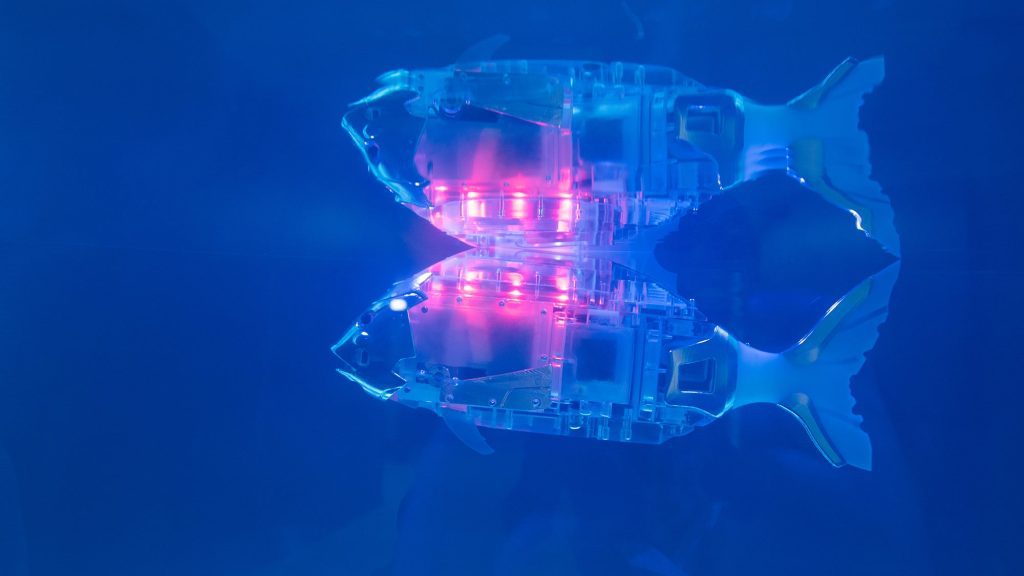This article was originally featured on Hakai Magazine,
Human technology has often been inspired by nature: The first airplanes were based on birds, and the inventor of Velcro got the idea from sticky burrs on his dog. In recent years, engineers developing ocean exploration technology have looked to fish for inspiration.
Researchers worldwide are creating robots that mimic fish in appearance and movement, claiming that these aquatic robots are more affordable, user-friendly, and less disruptive to sea life compared to the current remotely operated vehicles (ROVs) used by scientists. In a recent review of the technology’s advances, scientists say that only a few technical challenges stand in the way of a fish robot revolution.
Over the years, engineers have made prototype robot fish for various purposes. Some are designed for specific tasks, like tricking other fish in a lab, simulating fish movements, or collecting plastic from the ocean. The majority are meant for ocean exploration, equipped with cameras to document marine life and sensors to measure depth, temperature, and acidity. Certain models, such as the CIA-developed robotic catfish named Charlie, can even take and store water samples. Although current ROVs can perform these tasks and more, the review’s authors argue that robot fish will be the future tools., Weicheng Cui, a marine engineer at Westlake University in China and coauthor of the review, believes that robot fish can handle the tasks currently done by ROVs and may also tackle tasks beyond the capabilities of current ROVs., or Since the creation of the first tethered ROV in 1953—a contraption named
—scientists have increasingly used ROVs to explore the deep and dangerous parts of the ocean. ROVs can access depths unreachable by divers, spend extensive time there, and retrieve specimens, both living and non-living, from their expeditions.
Although ROVs have been beneficial for science, most models are large and costly. Those used by scientific organizations weigh nearly as much as a rhinoceros, cost millions of dollars, and require a crane for deployment and a tether to a mother ship while in the water.
On the other hand, robot fish are battery-powered, typically lightweight, and relatively inexpensive. Althoughsome robot fish are made to look like real fish Poodle, most are plain in color and only resemble fish in shape. Yet, according to Tsam Lung You, an engineer at the University of Bristol in England, even the most unrealistic robot fish are less disruptive to aquatic life than the average ROV.
Robotic fish swim using their tails instead of propellers, which allows them to move quietly through water without disturbing marine life. This is helpful for researchers studying underwater organisms in their natural environments.
Because robotic fish are small and sneaky, scientists could use them to observe delicate species or explore hard-to-reach places like coral reefs, lava tubes, and undersea caves. However, current models have a major drawback—a limited range due to power and battery constraints. Robotic fish require a docking station to autonomously recharge their batteries before they can replace modern ROVs. The vision is for groups of small robotic fish to work together and take turns docking at underwater charging stations powered by renewable energy sources like wave power.Cui proposes using multiple robotic fish instead of just one ROV to significantly improve deep-sea operations’ efficiency.
This vision hinges on the development of autonomous underwater charging stations, which Cui and his colleagues believe can be constructed using existing technologies. The core of the potential docking station would likely be a wireless charging system. Cui believes this future scenario could become a reality in less than ten years if there is enough demand.
However, convincing scientists to switch from ROVs to schools of robotic fish may be challenging, according to Paul Clarkson, director of husbandry operations at the Monterey Bay Aquarium in California.
Clarkson underscores the importance of the remotely operated vehicles (ROVs) provided by their research and technology partner, MBARI, which are essential tools for their work and research.
Nevertheless, Clarkson acknowledges the need to consider the advantages of new innovations in understanding and addressing the threats of climate change, habitat destruction, overfishing, and plastic pollution.
This article was originally published in
Hakai Magazine
and is reprinted here with permission.
Researchers suggest that swarms of robotic fish could render traditional underwater research vehicles obsolete.
This article first appeared in Hakai Magazine and is republished here with permission.









